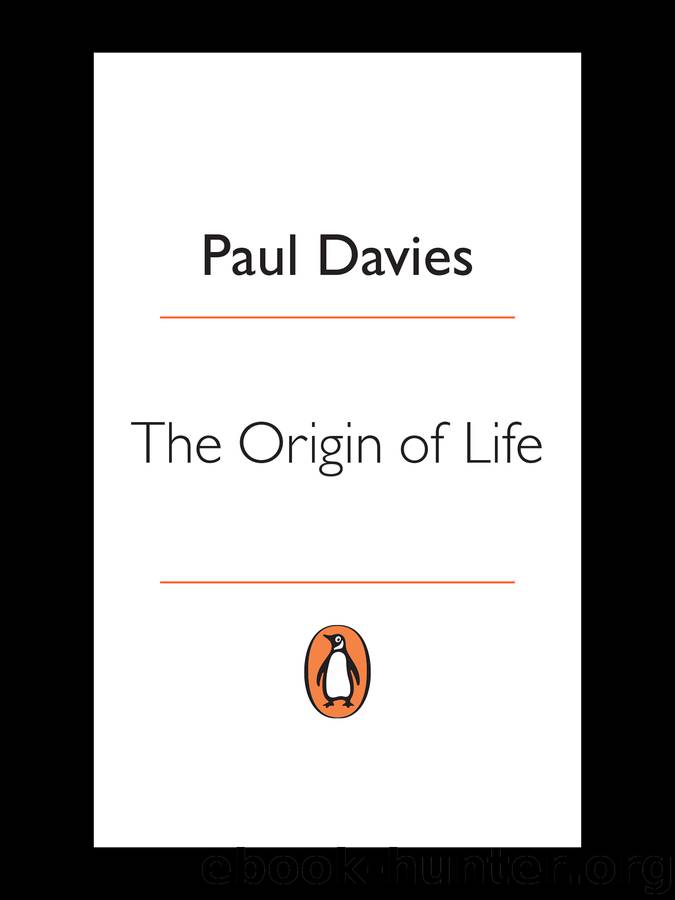The Origin of Life by Paul Davies

Author:Paul Davies
Language: eng
Format: epub, mobi
ISBN: 9780141941837
Publisher: Penguin Books Ltd
Published: 2008-11-21T16:00:00+00:00
The Sisyphus Effect
The discovery that Earth and Moon endured a punishing cosmic barrage until 3.8 billion years ago presents us with a major puzzle. If the fossil record is to be believed, life was certainly flourishing 3.5 billion years ago, and quite possibly as early as 3.85 billion years ago. Given the dire consequences of a major impact, could life have endured through the late heavy bombardment? Unfortunately, the trail of evidence goes cold just as this problem gets interesting. Although geologists have found isolated zircon crystals 4.4 billion years old, and inferred that some sort of solid crust must have existed at that time, the oldest intact rocks ever found date back 4.03 billion years. Geological processes have eradicated almost all evidence of what our planet may have been like before about 3.8 billion years ago.
Though Earth may be reluctant to yield the secrets of her youth, indirect evidence for conditions prior to 3.8 billion years ago may lie right under (even within!) our noses. The DNA of our bodies contains a record of the past, because our genes have been fashioned by environmental circumstances. Though the genetic record, like the geological record, has been garbled and obscured by the ravages of time, it is not completely erased. By prising out information from genes, microbiologists can tell a lot about the universal ancestor that may have lived some four billion years ago, and with this information we may guess something about the conditions that prevailed at the time. The message that emerges is quite a surprise.
Imagine what it was like during the epoch of heavy cosmic bombardment. Every large impact created global upheaval. The scale of the mayhem was far worse even than the dinosaur-destroying blast. As late as 3.8 billion years ago the Moon was hit by an object 90 km in diameter, producing a colossal impact basin the size of the British Isles. Several similar cataclysms have left signs of their damage in the form of mountain rings. Being that much bigger, Earth must have suffered dozens of collisions of this magnitude, as well as some that were even larger. Nor are the culprits for these mega-impacts hard to find. There are many large bodies lurking in the solar system even today. Chiron, a recently-discovered planetesimal, is on an unstable orbit near Saturn and measures 180 km across. The consequences of it hitting the Earth are too horrible to contemplate. And Chiron is by no means the largest known minor planet. Four billion years ago such objects would have been far more common than they are today.
The dramatic effects of massive collisions have been analysed by Norman Sleep and his colleagues at Stanford University.6 An impactor 500 km in diameter would excavate a hole 1500 km across and at least 50 km deep. A huge volume of rock would be vaporized in a gigantic fireball that would spread rapidly around the planet, displacing the atmosphere and creating a global furnace. The surface temperature would soar to more
Download
This site does not store any files on its server. We only index and link to content provided by other sites. Please contact the content providers to delete copyright contents if any and email us, we'll remove relevant links or contents immediately.
| Anatomy | Animals |
| Bacteriology | Biochemistry |
| Bioelectricity | Bioinformatics |
| Biology | Biophysics |
| Biotechnology | Botany |
| Ecology | Genetics |
| Paleontology | Plants |
| Taxonomic Classification | Zoology |
Sapiens: A Brief History of Humankind by Yuval Noah Harari(14322)
The Tidewater Tales by John Barth(12627)
Mastermind: How to Think Like Sherlock Holmes by Maria Konnikova(7281)
Do No Harm Stories of Life, Death and Brain Surgery by Henry Marsh(6908)
The Thirst by Nesbo Jo(6882)
Why We Sleep: Unlocking the Power of Sleep and Dreams by Matthew Walker(6659)
Life 3.0: Being Human in the Age of Artificial Intelligence by Tegmark Max(5520)
Sapiens by Yuval Noah Harari(5328)
The Longevity Diet by Valter Longo(5044)
The Body: A Guide for Occupants by Bill Bryson(5033)
The Rules Do Not Apply by Ariel Levy(4912)
The Immortal Life of Henrietta Lacks by Rebecca Skloot(4552)
Animal Frequency by Melissa Alvarez(4431)
Why We Sleep by Matthew Walker(4395)
The Hacking of the American Mind by Robert H. Lustig(4342)
Yoga Anatomy by Kaminoff Leslie(4336)
All Creatures Great and Small by James Herriot(4277)
Double Down (Diary of a Wimpy Kid Book 11) by Jeff Kinney(4244)
Embedded Programming with Modern C++ Cookbook by Igor Viarheichyk(4144)
